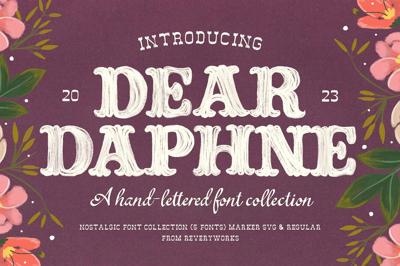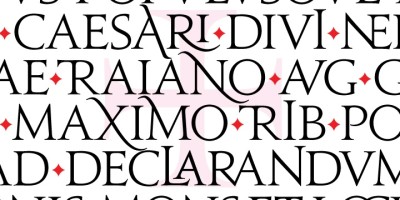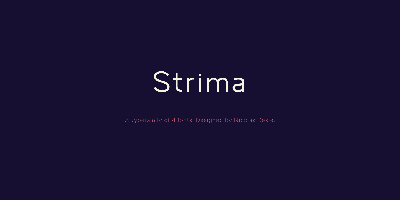Election Year Typography: Political Campaign Font Choices in America
Election Year Typography: Political Campaign Font Choices in America
Typography in American political campaigns carries the weight of democracy itself, shaping voter perceptions and influencing electoral outcomes in ways that extend far beyond conscious awareness. Every font choice communicates values, trustworthiness, leadership qualities, and ideological positioning to millions of voters making critical decisions about America's future.
From the bold sans-serif confidence of presidential campaigns to the approachable scripts of local candidates, political typography operates in the highest-stakes communication environment imaginable. Understanding how fonts influence voter psychology and campaign effectiveness provides crucial insights for political professionals, designers, and citizens seeking to understand the visual language of American democracy.
This comprehensive analysis examines political campaign typography across the American electoral spectrum, revealing how font choices shape voter perceptions and campaign success while providing practical guidance for political communicators navigating the complex visual landscape of election-year marketing.
The Psychology of Political Typography
Trust and Authority Through Letterforms
Political typography operates in environments where trust and credibility determine electoral success or failure. Voters make rapid judgments about candidate competence, integrity, and leadership potential based on visual cues that include typography choices, often before processing campaign messages or policy positions.
Research conducted during recent American election cycles reveals that serif fonts consistently score higher in voter trust assessments compared to sans-serif alternatives, particularly among older demographics who comprise reliable voting blocs. However, younger voters often respond more positively to clean, modern sans-serif fonts that suggest innovation and contemporary relevance.
These generational differences create strategic challenges for campaigns seeking broad coalition appeal while maintaining consistent visual identity across diverse voter segments and communication platforms.
Ideological Positioning Through Font Selection
Typography choices communicate ideological positioning and political values before voters read campaign content. Conservative campaigns often favor traditional serif fonts that suggest institutional authority, historical continuity, and respect for established systems. Progressive campaigns frequently choose modern sans-serif fonts that suggest innovation, change, and forward-thinking leadership.
These associations aren't accidental – they reflect decades of American political communication patterns that have trained voters to interpret typographic signals as indicators of political philosophy and governing approach.
Emotional Resonance and Voter Connection
Political typography must create emotional connections that motivate voter participation and campaign support. Fonts that feel too corporate or impersonal can distance candidates from voters, while overly casual or decorative fonts may undermine perceptions of leadership competence.
Successful political typography balances approachability with authority, creating visual communications that feel both presidential and personally relatable depending on the office sought and target audience characteristics.
Presidential Campaign Typography: The Ultimate Stakes
Historical Patterns in Presidential Typography
American presidential campaigns have established typographic patterns that reflect broader cultural and technological shifts while maintaining core elements that communicate presidential authority and national leadership capacity.
Barack Obama (2008, 2012): The Obama campaigns revolutionized political typography with custom fonts that balanced contemporary appeal with institutional credibility. The clean, modern aesthetics suggested technological competence and innovative leadership while maintaining enough traditional elements to reassure conservative-leaning voters about presidential readiness.
Donald Trump (2016, 2020): Trump campaigns employed bold, condensed fonts that suggested strength, decisiveness, and anti-establishment positioning. The typography choices reinforced campaign messaging about disrupting traditional political systems while projecting confidence and unwavering determination.
Joe Biden (2020): Biden's campaign typography emphasized stability, experience, and institutional knowledge through font choices that suggested steady leadership and return to traditional governmental norms. The visual approach balanced innovation with reassurance, appealing to voters seeking both change and stability.
Contemporary Presidential Typography Trends
Modern presidential campaigns increasingly employ custom typography systems that provide distinctive visual identity while optimizing performance across digital platforms and traditional media. These comprehensive font families enable consistent messaging across unprecedented numbers of communication touchpoints while maintaining flexibility for different contexts and audiences.
Variable fonts have become particularly valuable for presidential campaigns requiring typography that adapts seamlessly across massive digital advertising buys, social media campaigns, and traditional print materials while maintaining brand consistency and optimal performance.
Congressional and Senate Campaign Typography
Authority Without Intimidation
Congressional campaigns require typography that suggests legislative competence and policy expertise while remaining approachable for diverse district populations. These campaigns often favor fonts that split the difference between presidential authority and local accessibility.
Crimson Text and Source Serif Pro provide excellent options for congressional candidates seeking to establish policy credibility and institutional readiness while maintaining readability across campaign materials and digital platforms.
Lora and Merriweather offer serif alternatives that suggest competence and thoughtfulness while maintaining enough warmth for personal connection with constituents across diverse demographic groups.
Regional Adaptation Strategies
Congressional districts span vastly different American regions with distinct political cultures and aesthetic preferences. Successful congressional typography adapts to local preferences while maintaining enough consistency for name recognition and brand building.
Rural districts often respond positively to straightforward, honest fonts like PT Sans or Source Sans Pro that suggest practical problem-solving and down-to-earth representation. Urban districts may prefer more sophisticated options like Inter or Montserrat that suggest policy innovation and technological competence.
Suburban districts, increasingly crucial for electoral success, often favor fonts that balance these approaches – sophisticated enough for educated voters while approachable enough for busy families focused on practical governance outcomes.
State and Local Campaign Typography
Gubernatorial Leadership Positioning
Gubernatorial campaigns require typography that suggests executive competence and state-level leadership capacity while remaining connected to local values and priorities. These campaigns often choose fonts that split the difference between national political aesthetics and regional character.
Libre Baskerville and Playfair Display work well for gubernatorial candidates in states with strong educational or cultural institutions, suggesting intellectual leadership and policy sophistication.
Open Sans and Lato provide excellent options for gubernatorial campaigns seeking broad appeal across diverse state populations while maintaining enough character for distinctive political positioning.
Mayoral and Local Accessibility
Local political campaigns prioritize accessibility and personal connection over national political symbolism. Typography choices must suggest competence and leadership while maintaining the approachable character essential for local political success.
Nunito and Quicksand offer friendly, approachable options for local campaigns seeking to emphasize community connection and responsive governance.
Ubuntu and Cabin provide fonts that balance professionalism with personal warmth, ideal for candidates seeking to project both competence and approachability in local political contexts.
Party-Specific Typography Patterns
Democratic Campaign Typography Trends
Democratic campaigns consistently favor fonts that suggest innovation, inclusion, and forward-thinking governance while maintaining institutional credibility and broad appeal across diverse coalitions.
Sans-serif fonts like Source Sans Pro, Lato, and Open Sans appear frequently in Democratic campaigns seeking to project modern problem-solving approaches and technological competence.
However, Democratic campaigns targeting older voters or emphasizing institutional experience often incorporate serif elements that suggest stability and governmental continuity.
Republican Campaign Typography Approaches
Republican campaigns often choose fonts that suggest traditional values, institutional authority, and strong leadership while appealing to both conservative base voters and persuadable independents.
Serif fonts like Crimson Text, Libre Baskerville, and Source Serif Pro frequently appear in Republican campaigns emphasizing experience, traditional values, and institutional respect.
Contemporary Republican campaigns increasingly balance traditional elements with modern fonts that suggest efficient governance and business-like problem-solving approaches.
Independent and Third-Party Typography
Independent campaigns face unique typography challenges, needing fonts that suggest credibility and competence while clearly differentiating from major party alternatives.
These campaigns often choose distinctive fonts that suggest independence and fresh thinking without appearing unprofessional or fringe. Raleway, Montserrat, and Work Sans provide options that feel both distinctive and credible for independent political communications.
Issue-Based Campaign Typography
Ballot Initiative and Referendum Communications
Issue-based campaigns require typography that clearly communicates complex policy positions while motivating voter action on specific ballot measures or referenda.
Educational Campaigns: Use highly readable fonts like Source Sans Pro or Open Sans that ensure complex policy information remains accessible to diverse voter populations with varying educational backgrounds.
Advocacy Campaigns: Employ fonts with enough character to capture attention and create emotional connection while maintaining credibility for serious policy discussions. Lato and Nunito often work well for advocacy communications seeking broad appeal.
Opposition Research and Negative Campaigning
Negative campaign materials require typography that maintains credibility and authority while delivering critical messages about opposing candidates or positions.
Fonts like Inter or Source Sans Pro provide clean, authoritative presentation for opposition research materials that must appear factual and credible rather than inflammatory or partisan.
Digital Campaign Typography Optimization
Social Media Political Communication
Political campaigns now conduct significant portions of voter communication through social media platforms with specific technical requirements and audience behaviors.
Facebook and Instagram: Use bold, readable fonts like Oswald or Montserrat that remain legible in small preview images while capturing attention in crowded social media feeds.
Twitter/X Communications: Choose fonts like Source Sans Pro or Inter that maintain readability across different devices while ensuring political messages remain clear and authoritative.
TikTok and Video Platforms: Employ fonts like Fredoka One or Nunito that work well for younger audiences while maintaining enough professionalism for political content.
Email Campaign Optimization
Political email campaigns require typography that performs reliably across diverse email clients while maintaining political authority and encouraging voter action.
Newsletter Communications: Use fonts like Source Sans Pro or Lato that ensure content readability across different devices and email platforms while maintaining political credibility.
Fundraising Appeals: Choose fonts that balance urgency with authority, often employing bold weights of reliable fonts like Open Sans or Montserrat for critical fundraising communications.
Crisis Communication Typography
Scandal and Crisis Response
Political crisis communications require typography that projects competence, transparency, and authoritative response while rebuilding damaged trust and credibility.
Serif fonts like Crimson Text or Source Serif Pro often work well for formal crisis statements requiring institutional authority and credible communication.
Sans-serif options like Source Sans Pro or Inter provide clean, transparent aesthetics for crisis communications emphasizing honesty and direct voter communication.
Debate and Public Speaking Materials
Political debates and public speaking events require typography that supports quick reference and confident delivery while maintaining professional presentation standards.
Large, clear fonts like Open Sans or Source Sans Pro in generous sizes ensure political speakers can quickly reference talking points and policy positions during high-pressure public appearances.
Ethical Considerations in Political Typography
Accessibility and Democratic Participation
Political typography must support democratic participation by ensuring campaign materials remain accessible to voters with diverse abilities and technological access levels.
Maintain WCAG accessibility standards for political websites and digital materials, ensuring that font choices don't exclude voters with visual impairments or other disabilities from political participation.
Truth and Transparency in Visual Communication
Typography choices can enhance or undermine truthful political communication. Fonts that appear to manipulate or obscure information can damage democratic discourse and voter trust.
Choose fonts that support clear, honest political communication rather than visual manipulation or emotional manipulation that undermines informed democratic decision-making.
Future Trends in Political Typography
AI and Personalized Political Communication
Emerging technologies enable personalized political typography that adapts to individual voter preferences and demographic characteristics, raising questions about manipulation and democratic equality.
Deepfake and Misinformation Challenges
Political typography must evolve to help voters identify authentic campaign communications amid increasing concerns about deepfake technology and visual misinformation in political contexts.
Global Influence and Cultural Exchange
American political typography increasingly influences and is influenced by international political communication patterns, creating opportunities for innovation while raising questions about democratic authenticity.
Political campaign typography operates at the intersection of design, psychology, and democracy, shaping voter perceptions and electoral outcomes through visual choices that extend far beyond aesthetic preference. Understanding these patterns provides crucial insights into American political communication while informing more effective and ethical political design practices.
Whether you're designing political campaigns, analyzing electoral communications, or simply seeking to understand the visual language of American democracy, the typography choices examined in this guide reveal the sophisticated ways that fonts influence political perception and democratic participation in the United States.
The fonts that shape American elections today will influence democratic discourse for generations, making thoughtful political typography not just a design challenge but a civic responsibility.




